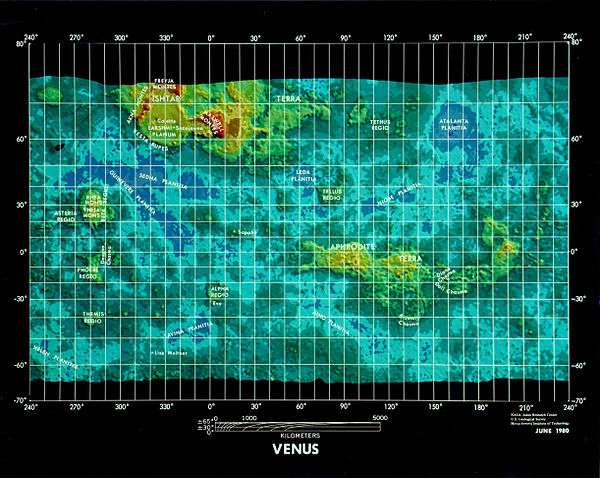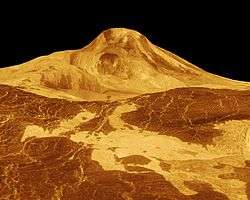Pioneer Venus Orbiter
 Pioneer Venus Orbiter | |
| Mission type | Venus orbiter |
|---|---|
| Operator | NASA / ARC |
| COSPAR ID | 1978-051A |
| SATCAT № | 10911 |
| Website | Pioneer Venus at NASA |
| Mission duration |
14 years, 4 months, 18 days (from launch) 13 years, 10 months, 4 days (at Venus) |
| Spacecraft properties | |
| Bus | HS-507 |
| Manufacturer | Hughes |
| Launch mass | 582 kg (1,283 lb) |
| Power | 312 watts |
| Start of mission | |
| Launch date | May 20, 1978, 13:13:00 UTC |
| Rocket | Atlas SLV-3D Centaur-D1AR |
| Launch site | Cape Canaveral LC-36A |
| End of mission | |
| Last contact | October 8, 1992, 19:22 UTC |
| Decay date | October 22, 1992[1] |
| Orbital parameters | |
| Reference system | Cytherocentric |
| Semi-major axis | 33,405.8 kilometres (20,757.4 mi) |
| Eccentricity | 0.842 |
| Pericytherion | 181.6 kilometers (112.8 mi) |
| Apocytherion | 66,630 kilometers (41,400 mi) |
| Inclination | 105 degrees |
| Period | 24 hours |
| Venus orbiter | |
| Orbital insertion | December 4, 1978 |
The Pioneer Venus Orbiter, also known as Pioneer Venus 1 or Pioneer 12, was a mission to Venus conducted as part of the Pioneer Venus project. Launched in May 1978 atop an Atlas-Centaur rocket, the spacecraft was inserted into an elliptical orbit around Venus on December 4, 1978. It returned data on Venus until October 1992.[1][2]
Launch and arrival at Venus

The Pioneer Venus Orbiter was launched by an Atlas SLV-3D Centaur-D1AR rocket, which flew from Launch Complex 36A at the Cape Canaveral Air Force Station. The launch occurred at 13:13:00 on May 20, 1978, and deployed the Orbiter into heliocentric orbit for its coast to Venus. Venus orbit insertion occurred on December 4, 1978.
Spacecraft

Manufactured by Hughes Aircraft Company, the Pioneer Venus Orbiter was based on the HS-507 bus.[3] The spacecraft was a flat cylinder, 2.5 meters (8.2 ft) in diameter and 1.2 meters (3.9 ft) long. All instruments and spacecraft subsystems were mounted on the forward end of the cylinder, except the magnetometer, which was at the end of a 4.7 meters (15 ft) boom. A solar array extended around the circumference of the cylinder. A 1.09 metres (3 ft 7 in) despun dish antenna provided S and X band communication with Earth. A Star-24 solid rocket motor was integrated into the spacecraft to provide the thrust to enter orbit around Venus.[3]
From Venus orbit insertion to July 1980, periapsis was held between 142 and 253 kilometres (88 and 157 mi) (at 17 degrees north latitude) to facilitate radar and ionospheric measurements. The spacecraft was in a 24-hour orbit with an apoapsis of 66,900 kilometers (41,600 mi). Thereafter, the periapsis was allowed to rise to a maximum of 2,290 kilometres (1,420 mi) and then fall, to conserve fuel.
In 1991, the Radar Mapper was reactivated to investigate previously inaccessible southern portions of the planet, in conjunction with the recently arrived Magellan spacecraft. In May 1992, Pioneer Venus began the final phase of its mission, in which the periapsis was held between 150 and 250 kilometres (93 and 155 mi), until the spacecraft's propellant was exhausted, after which the orbit decayed naturally. The spacecraft continued to return data until 8 October 1992, with the last signals being received at 19:22 UTC.[2] The Pioneer Venus Orbiter disintegrated upon entering the atmosphere of Venus on October 22, 1992.[1]
Experiments

The Pioneer Venus Orbiter carried 17 experiments with a total mass of 45 kg: [4]

- a cloud photo-polarimeter (OCPP) to measure the vertical distribution of the clouds, similar to Pioneer 10 and Pioneer 11 imaging photo-polarimeter (IPP)
- a surface radar mapper (ORAD) to determine topography and surface characteristics. Observations could only be conducted when the probe was closer than 4700 km over the planet. A 20 Watt S-band signal (1.757 gigahertz) was sent to the surface that reflected it, with the probe analyzing the echo. Resolution at periapsis was 23 x 7 km.
- an infrared radiometer (OIR) to measure IR emissions from Venus' atmosphere
- an airglow ultraviolet spectrometer (OUVS) to measure scattered and emitted UV light
- a neutral mass spectrometer (ONMS) to determine the composition of the upper atmosphere
- a solar wind plasma analyzer (OPA) to measure properties of the solar wind
- a magnetometer (OMAG) to characterize the magnetic field at Venus
- an electric field detector (OEFD) to study the solar wind and its interactions
- an electron temperature (OETP) to study the thermal properties of the ionosphere
- an ion mass spectrometer (OIMS) to characterize the ionospheric ion population
- a charged particle retarding potential analyzer (ORPA) to study ionospheric particles
- two radio science experiments to determine the gravity field of Venus
- a radio occultation experiment to characterize the atmosphere
- an atmospheric drag experiment to study the upper atmosphere
- a radio science atmospheric and solar wind turbulence experiment
- a gamma ray burst (OGBD) detector to record gamma ray burst events
The spacecraft conducted radar altimetry observations allowing the first global topographic map of the Venusian surface to be constructed.
Observations of Halley's Comet
From its orbit of Venus, the Pioneer Venus Orbiter was able to observe Halley's Comet when it was unobservable from Earth due to its proximity to the sun during February 1986. UV spectrometer observations monitored the loss of water from the comet's nucleus at perihelion on February 9.[5]
See also
References
- 1 2 3 McDowell, Jonathan. "Satellite Catalog". Jonathan's Space Page. Archived from the original on 2003-10-11.
- 1 2 "Pioneer Venus 1". Solar System Exploration. NASA. Archived from the original on 2006-10-04.
- 1 2 Krebs, Gunter. "Pioneer 12 (Pioneer Venus Orbiter, PVO)". Gunter's Space Page. Archived from the original on 2005-01-12.
- ↑ "Pioneer Venus Project Information". NASA Goddard Space Flight Center. Retrieved 2016-08-17.
- ↑ Russell, C.T.; Luhmann, J.G.; Scarf, F.L. (1985). "Pioneer Venus Observations during Comet Halley's Inferior Conjunction" (PDF). University of California, Los Angeles. Archived (PDF) from the original on 2009-02-27.
External links
| Wikimedia Commons has media related to Pioneer Venus project. |
- NASA: Pioneer Venus Project Information
- Pioneer Venus Program Page by NASA's Solar System Exploration
- Several articles in Science (1979), 205, pages 41-121
- Kasprzak, W. T - The Pioneer Venus Orbiter: 11 years of data. (May 1, 1990) - NASA




